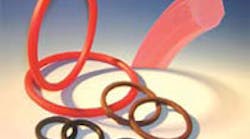The Octi-ring was specifically designed to combat the effects of the high-speed small strokes that a standard issue O-ring is incapable of handling.
|
We generally assume that a moving part will wear out faster than one that remains stationary. When a hydraulic cylinder begins to leak, for example, it is usually a dynamic seal that needs to be replaced. But an increasing number of hydraulic cylinders is now being sent out for repair because of the failure of a particular static seal, the end cap O-ring.
The O-ring is designed to have a static point contact with the tube that forms the cylinder barrel. The O-ring is positioned in the end cap to allow the end cap to seal system pressure. The point contact creates a high local stress that is able to contain high pressure without exceeding the yield stress of the O-ring body. The flexible nature of O-ring material accommodates imperfections in the mounting parts.
As long as the contact between the O-ring and the sealing surface remains unbroken, this design provides a good economical solution to the challenge of sealing the pressure. However, in operation, the contact between the O-ring and the sealing surface does not remain static in a large and increasing number of hydraulic cylinders. In these cylinders, a static seal is working as if it were dynamic.
Any hydraulic cylinder that experiences pressure cycling also experiences tube expansion and contraction. Under these circumstances, the change in dimension of the diameter of the tube leads to a corresponding change in axial length of the tube. Normally, these changes are measured in microns, take place in a millisecond, and do not compromise system integrity. The effects of these small, fast movements can, however, produce fatigue damage on the O-ring as it is rolled and twisted in the groove by these movements. Many large cylinders are taken out of service simply because of the failure of one O-ring.
Solving the challenge of end-cap Oring failure prompted American High Performance Seals, Oakdale, Pa., to develop the Octi-ring, an eight-sided version of an O-ring. The corners of the Octi-ring have smooth surface finish chamfers to combat the effects of the high-speed, short strokes that standard O-rings cannot. These chamfers are precisely calculated and tightly controlled by manufacturing them on may not be static a CNC lathe to ensure that the seal remains tight without exhibiting fatigue damage.
The AHP Seals Octi-ring has been in service for more than two years in a variety of applications and has a strong record of eliminating O-ring failures in hydraulic cylinders. In one case, AHP Seals supplied Octi-rings to Downard Hydraulics, Princeton, W. Va., for an application on a coke oven in Alabama. The hydraulic cylinders serve as brakes that hold loaded rail cars in position prior to rotary dumping of the coal into an oven. The cylinders, which are mounted beneath the tracks and are subject to dirt, water, and the elements, operate at 1500 psi and 200° F. High pressure caused the cylinder walls to expand and contract during operation, creating fatigue damage to the end cap O-rings. Prior to contacting Downard Hydraulics, the coke oven operator was changing five cylinders a week.
Downard Hydraulics chose to incorporate one of AHP Seals’ Octi-rings in its cylinder design. In the 10 months since the Octi-ring was incorporated into the system, the coke oven operator has not changed a single cylinder. For more information on the Octiring, contact American High Performance Seals, Inc., at (800) 283-7140 or visit www.ahpseals.com.


